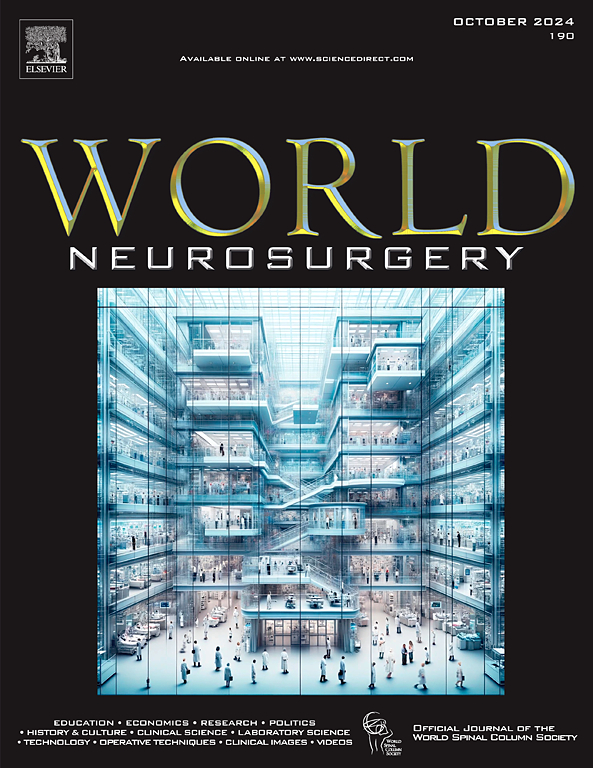Constructing a Digital Bridge: A Systematic Review Assessing Electronic Medical Record and Telehealth Implementation for Neurosurgery in Uganda
IF 1.9
4区 医学
Q3 CLINICAL NEUROLOGY
引用次数: 0
Abstract
Background
Neurosurgical care in Uganda faces significant challenges due to workforce shortages, infrastructure limitations, and a lack of digital health tools. Implementing electronic medical records (EMRs) and telehealth could improve neurosurgical outcomes, but adoption remains low. This systematic review examines barriers and facilitators to EMR and telehealth implementation in Ugandan neurosurgery to identify opportunities for improvement.
Methods
A systematic review was conducted following Preferred Reporting Items for Systematic reviews and Meta-Analyses 2020 guidelines across PubMed, Google Scholar, and Scopus to identify studies published from 2007 to 2024 evaluating EMR and telehealth adoption in Uganda. Thematic analysis categorized barriers and facilitators into 10 distinct themes. Statistical analysis for frequency and correlation with technologies were performed using χ2 analysis and Pearson residual tests, with statistical significance set at P < 0.1.
Results
Key barriers include technological infrastructure inefficiencies (24%), systemic and operational limitations (16%), and technical competency and training deficits (13%). Similarly, the primary facilitators include infrastructure reliability (22%), training and education investment (13%), and community engagement (13%). Notably, telehealth adoption was more significantly impacted by human resource limitations (P < 0.05), whereas EMR implementation was hindered by systemic inefficiencies (P < 0.05).
Conclusions
Addressing Uganda’s digital health gaps requires cost-effective and scalable strategies, including mobile-based EMRs, teleconsultation frameworks, and structured workforce training. Future research should focus on developing implementation models tailored to low-resource settings, ensuring feasibility and sustainability. This study aims to contribute to the growing discourse on digital solutions for resource-limited healthcare, with a particular emphasis on innovation in global neurosurgical care.
构建数字桥梁:评估乌干达神经外科EMR和远程医疗实施的系统综述。
背景:由于劳动力短缺、基础设施限制和缺乏数字健康工具,乌干达的神经外科护理面临着重大挑战。实施电子医疗记录(EMR)和远程医疗可以改善神经外科手术的结果,但采用率仍然很低。目的:本系统综述检查乌干达神经外科电子病历和远程医疗实施的障碍和促进因素,以确定改进的机会。方法:根据PRISMA 2020指南对PubMed、谷歌Scholar和Scopus进行系统评价,以确定2007年至2024年发表的评估乌干达电子病历和远程医疗采用的研究。主题分析将障碍和促进因素分为十个不同的主题。使用卡方分析和Pearson残差检验对频率和与技术的相关性进行统计分析,P < 0.1为统计学显著性。结果:主要障碍包括技术基础设施效率低下(24%)、系统和操作限制(16%)以及技术能力和培训缺陷(13%)。同样,主要的促进因素包括基础设施可靠性(22%)、培训和教育投资(13%)以及社区参与(13%)。值得注意的是,远程医疗的采用受到人力资源限制的影响更大(p结论:解决乌干达的数字卫生差距需要具有成本效益和可扩展的战略,包括基于移动的电子病历、远程咨询框架和结构化的劳动力培训。未来的研究应侧重于开发适合低资源环境的实施模式,确保可行性和可持续性。本研究旨在促进对资源有限的医疗保健数字解决方案的日益增长的讨论,特别强调全球神经外科护理的创新。
本文章由计算机程序翻译,如有差异,请以英文原文为准。
求助全文
约1分钟内获得全文
求助全文
来源期刊

World neurosurgery
CLINICAL NEUROLOGY-SURGERY
CiteScore
3.90
自引率
15.00%
发文量
1765
审稿时长
47 days
期刊介绍:
World Neurosurgery has an open access mirror journal World Neurosurgery: X, sharing the same aims and scope, editorial team, submission system and rigorous peer review.
The journal''s mission is to:
-To provide a first-class international forum and a 2-way conduit for dialogue that is relevant to neurosurgeons and providers who care for neurosurgery patients. The categories of the exchanged information include clinical and basic science, as well as global information that provide social, political, educational, economic, cultural or societal insights and knowledge that are of significance and relevance to worldwide neurosurgery patient care.
-To act as a primary intellectual catalyst for the stimulation of creativity, the creation of new knowledge, and the enhancement of quality neurosurgical care worldwide.
-To provide a forum for communication that enriches the lives of all neurosurgeons and their colleagues; and, in so doing, enriches the lives of their patients.
Topics to be addressed in World Neurosurgery include: EDUCATION, ECONOMICS, RESEARCH, POLITICS, HISTORY, CULTURE, CLINICAL SCIENCE, LABORATORY SCIENCE, TECHNOLOGY, OPERATIVE TECHNIQUES, CLINICAL IMAGES, VIDEOS
 求助内容:
求助内容: 应助结果提醒方式:
应助结果提醒方式:


